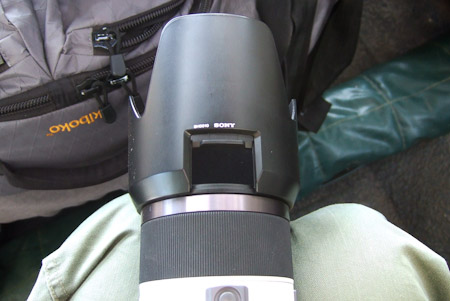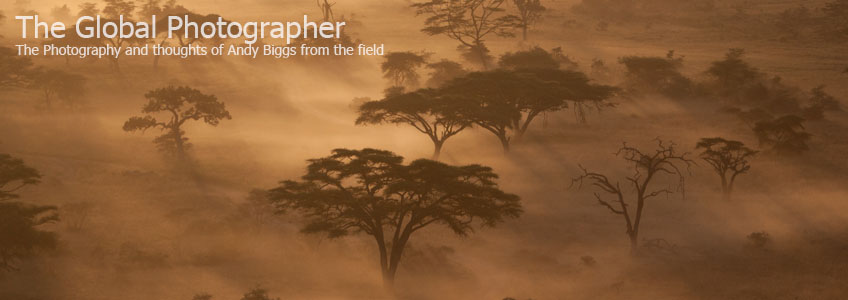Sony A900 and lenses - Namibia trip summary
 Tuesday, August 11, 2009 at 08:55PM
Tuesday, August 11, 2009 at 08:55PM I know it has been a few months since I have returned from my 3-week Namibia trip, and I have even been back on safari in Botswana in the meantime, but I thought I would throw together a quick summar of my feelings of the equipment that I used on the trip. So here goes.
I always travel to Africa with my Gura Gear Kiboko camera bag, as I started Gura Gear precisely because I was tired of all of the same old camera bags on the market. All are too heavy, uncomfortable, overpadded and not well thought out. My Kiboko bag allows me to not only get my gear to my locations in a lighter fashion, but it also allows me to have multiple cameras attached and ready to shoot from. This is accomplished by dividing the center of the camera bag into two separate 'butterfly' sides. In my Gura Gear Kiboko bag I carried the following:
- Sony A900 24mp SLR (x2)
- Sony 16-35mm f/2.8 Carl Zeiss
- Sony 24-70mm f/2.8 Carl Zeiss
- Sony 70-400mm f/4.5-5.6 G
- Extra batteries
- Compact Flash cards (112GB worth)
- Fleece jacket
- Marmot Precip shell for wind protection
- Filters
- Hat
- AMOD GPS tracker
And there was still more room left over. I have to fess up and say that I had an experimental version of the Kiboko bag with me, and it was a different size than the standard Kiboko bag. Was it larger or smaller? Only time will tell!
On this safari I opted for simplicity, and I didn't want to take extra gear with me. In hindsight I think it was a good choice but also a bad choice. Sony graciously loaned me a great set of cameras and lenses, and I had to choose what to take and what to leave at home. Here are the additional lenses that they sent to me that I did not take with me:
So let's dig into the details a little bit. My most used lens on the trip was the 24-70mm f/2.8 Carl Zeiss lens. It pretty much sat on one of the A900 bodies for the entire trip. It is built like a tank (a good thing), and performs exceptionally well. I really have nothing but praise to say about the lens, other than some vignetting when approaching 24mm in conjunction with a polarizing filter attached. I tried swapping out my polarizer for another traveler's slim polarizer, and it didn't make much difference, unfortunately.
The second most used lens was the 70-400mm f/4.5-5.6 G. This is a great lens, and is pretty much a blend between the Nikon 80-400mm and the Canon 100-400mm. Let me explain. Canon users pretty much hate the 100-400mm for its push-pull zoom design, as well as its optical quality over about 300mm. However, it does do a good job at autofocusing. The Nikon 80-400mm is optically decent and has a traditional zoom ring for zooming in and out. However, its great downfall is its atrocious autofocusing speed. Well, the Sony 70-400mm takes the good from both of those lenses and combines everything into 1 lens: good autofocusing speed, good optics and a traditional zoom ring. Pretty cool. The one thing that I really love about this lens (and also the 70-200mm f/2.8 G) is its lens shade. The lens shade has a nifty sliding door on the underneath side so the shooter can easily rotate a polarizing filter from underneath. Pretty cool!

The Sony 70-200mm f/2.8 with the slot on the bottom of the lens shade
The one thing that I don't think is necessary is the 70-400mm lens is painted in silver. Not my favorite color for a lens. I think they should match the same white color as the 70-200mm.
When we were shooting in high wind situations I really wish I had brought the 70-200mm. Why? Because the 70-400mm has a long barrell when zoomed out to 200mm or more. This barrel is slightly wobbly, and I ended up with many unusable images in these situations. I should have brought the 70-200mm in addition to the 70-400mm for this reason, as well as the lens is optically superior at equivalent focal lengths and at similar f/stops. The 70-400mm could have been used for wildlife and the long shots and the 70-200mm strictly for landscapes.
The 16-35mm Carl Zeiss lens was mostly used for people grab shots, and also at Kolmanskop ghost town. I found the lens to be every bit as good as its competitors from Nikon and Canon. The lens is also built in a similar way as the 24-70mm f/2.8 Carl Zeiss, which is a good thing indeed.
And now we get to the Sony A900 camera bodies. I first used the Sony A900 cameras on my polar bear trip this past November. My first impression was that Sony really hit the nail on the head with the product, as it had great specifications at a very competitive price. The A900 reminds me of how I felt about my old Nikon F100 in that it just feels good in my hands. After shooting with the A900 for 3 weeks in the desert, I am very glad that I wasn't carrying around the extra weight of a professional camera from Nikon or Canon. For landscapes the A900 is really about as ideal as a camera can get. The file size and quality is excellent, the ergonomics works well and the lenses cover everything I will ever need. There are some glitches, however, in that some of the buttons are difficult to reach without lifting an entire hand off of the camera. A good example is the ISO selection button is tough to reach with either my thumb or my forefinger. This is a small nit, for sure. One thing I love about the Sony system is the approach to handle image stabilization / vibration reduction in-camera. This means that *all* lenses are image stabilized. Very nice.
Looking forward into a crystal ball I can see reports that Sony is working on a super telephoto lens. This has me very intrigued as to the future of Sony and how it will play a part in wildlife photography, as well as sports photography. I am going to seek out other Sony cameras other than the A900 to see if there are other camera bodies that have better low noise characteristics, as this is something I rely on quite often. ISO 400 is now my starting point, ISO 800 is my late afternoon setting and ISO 1600 is a requirement at the end of the day. Heck, ISO 3200 and 6400 is a joy on my Nikon D3, but I recognize that no other cameras will be able to match this. I also don't shoot that many images at those higher sensitivities, so this isn't really a big deal to me.
I want to again thank Sony for loaning me some great equipment. It is a shame that I didn't take the time to use the 50mm and 135mm lenses, as they seem to be excellent performers as well. The 135mm is the one lens that I would like to try, as the build quality is top notch.



Reader Comments (8)
I'm seriously thinking about jumping to the A900 and the Zeiss lenses. If there were a way to use a new Canon TS-E II on that body, I think that I'd do it. I just can't seem to give up the rise/fall & tilt feature. I'd also like to have live view but not a deal breaker. Maybe the replacement for the A900 will have this all figured out.
Thanks for the review, Andy. Like the previous commenter, I too am seriously thinking about jumping from Canon to Sony (or at least going the dual systems route till things shake out a bit more or Canon finally offers something in which I'm interested or can afford). I do have a question tho. You say the 70-400 is "wobbly" when zoomed out. By that, do you mean the barrel itself is wobbly (loose, e.g. there's a build/fit issue) or that at 400, even with in camera IS it's hard to get an acceptably sharp image? If I do jump to Sony, I'd be using the 70-400 'as a whale lens, zoomed out a bunch from my boat. I'd love your input about the utility of the A900 (or whatever the upgrade might end up being) and the 70-400 for whales.
Cheers!
Joe (a/k/a "akclimber" on assorted photog forums, like NSN)
Joe, the 70-400mm is a great lens, but I was shooting landscapes on a tripod in a 15-20mph wind. Not the easiest. I wouldn't say that this is a build issue, but it is just one of those things to look out for.
Thanks Andy! I currently use a Canon 1D2n and 100-400 as my main whale combo. I'd give up the 8 fps for an "affordable" 24 MPs of FF goodness @ 5fps attached to a 70-400.
Cheers!
Hey Andy...Thanks for posting your impressions of the a900. I do mostly "street" photography and am looking for a useful full framer. As I write this the a850 just came out. What were your impressions of the AF. Decisions, decisions. Thanks again
The autofocus on the A900 isn't appreciably different than what a mid range Canon dSLR is like. Think Canon 50D or 5DMkII.
I'm curious about how well the a900 w/70-200 an d 70-400 AF tracks moving wildlife. Side to side shouldn't be a problem, but how well does it track an approaching elephant (large target with some contrast) or impala (smaller target with potentially less contrast)? How well does it track wildebeest doing their "running dance"? What comments do you have regarding the precision and speed of the AF in continuous mode.
That is a great question. I really don't know, as my time with the A900 system has only been with landscapes and other non or slow moving targets.